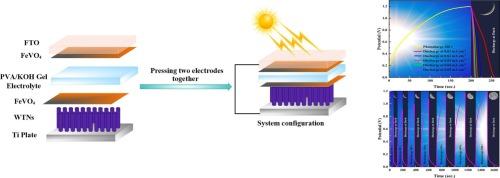基于FeVO4双功能光电极的光充电非对称超级电容器:一种新型能量收集与存储集成器件
IF 13.2
1区 工程技术
Q1 ENGINEERING, CHEMICAL
引用次数: 0
摘要
可持续阳光的有效利用为通过光辅助机制提高储能性能提供了一种实用的方法。光超级电容器是一种能够捕获和储存可再生太阳能的创新装置。本文成功地合成了一种由假容性钒酸铁(FeVO4)和光敏钨掺杂二氧化钛纳米管(WTNs)组成的新型FeVO4/WTNs光电极,并将其作为一种具有高电容性的新型光电极。优化后的FeVO4/WTNs(样品S3)在0.05 mA/cm2电流密度下的最大比电容为37 mF/cm2。该值明显超过了纯FeVO4和原始wtn中观察到的电容,突出了复合材料的电化学性能增强。在光照条件下,该电极的比电容达到69.11 mF/cm2,比光照条件下提高了85.9 %。采用FeVO4/WTNs和FeVO4/FTO电极制备的光辅助非对称超级电容器在0.01 mA/cm2下的比电容为0.75 mF/cm2。相比之下,该器件在没有光照的情况下使用传统方法进行测试,在相同电流密度下提供了0.56 mF/cm2的电容。当在无偏条件下光电充电至1.2 V时,该器件的比电容为0.24 mF/cm2。值得注意的是,该装置能够在200 秒内通过光充电产生1.2 V的电压,从而消除了对外部偏置电压的需要。该器件在10,000次恒流充放电循环中表现出优异的稳定性,在黑暗中保持87.44 %的容量,在照明下保持87.61 %的容量。在这项研究中,提出了一种基于FeVO4/WTNs电极制作光可充电超级电容器的简单方法。本文章由计算机程序翻译,如有差异,请以英文原文为准。

Photo-chargeable asymmetric supercapacitors based on FeVO4 dual-function photoelectrodes: A new energy harvesting and storage integrated device
The efficient utilization of sustainable sunlight offers a practical approach to improving energy storage performance through photo-assisted mechanisms. Photo-supercapacitors are innovative devices that can capture and store renewable solar energy. This work successfully synthesized a novel FeVO4/WTNs photoelectrode consisting of pseudocapacitive iron vanadate (FeVO4) and photosensitive tungsten-doped titania nanotubes (WTNs) and used as a new photoelectrode to achieve high capacitance. The optimized FeVO4/WTNs (sample S3) demonstrated a maximum specific capacitance of 37 mF/cm2 at a current density of 0.05 mA/cm2. This value significantly exceeds the capacitance observed in pure FeVO4 and pristine WTNs, highlighting the enhanced electrochemical performance of the composite material. Under light illumination, this electrode reached the specific capacitance of 69.11 mF/cm2, which corresponds to an increase of 85.9 % compared to dark conditions. A photo-assisted asymmetric supercapacitor using FeVO4/WTNs and FeVO4/FTO electrodes showed a specific capacitance of 0.75 mF/cm2 at 0.01 mA/cm2 under light irradiation. In contrast, the device tested without exposure to light, using a conventional method, delivered a capacitance of 0.56 mF/cm2 at the same current density. When photocharged to 1.2 V under unbiased conditions, this device had a specific capacitance of 0.24 mF/cm2. Remarkably, the device was able to generate a voltage of 1.2 V within 200 s by photocharging alone, eliminating the need for an external bias voltage. The device exhibited exceptional stability over 10,000 galvanostatic charge/discharge cycles and maintained 87.44 % capacity in the dark and 87.61 % under illumination. In this study, a simple approach to fabricate a photochargeable supercapacitor based on the FeVO4/WTNs electrode is presented.
求助全文
通过发布文献求助,成功后即可免费获取论文全文。
去求助
来源期刊

Chemical Engineering Journal
工程技术-工程:化工
CiteScore
21.70
自引率
9.30%
发文量
6781
审稿时长
2.4 months
期刊介绍:
The Chemical Engineering Journal is an international research journal that invites contributions of original and novel fundamental research. It aims to provide an international platform for presenting original fundamental research, interpretative reviews, and discussions on new developments in chemical engineering. The journal welcomes papers that describe novel theory and its practical application, as well as those that demonstrate the transfer of techniques from other disciplines. It also welcomes reports on carefully conducted experimental work that is soundly interpreted. The main focus of the journal is on original and rigorous research results that have broad significance. The Catalysis section within the Chemical Engineering Journal focuses specifically on Experimental and Theoretical studies in the fields of heterogeneous catalysis, molecular catalysis, and biocatalysis. These studies have industrial impact on various sectors such as chemicals, energy, materials, foods, healthcare, and environmental protection.
 求助内容:
求助内容: 应助结果提醒方式:
应助结果提醒方式:


